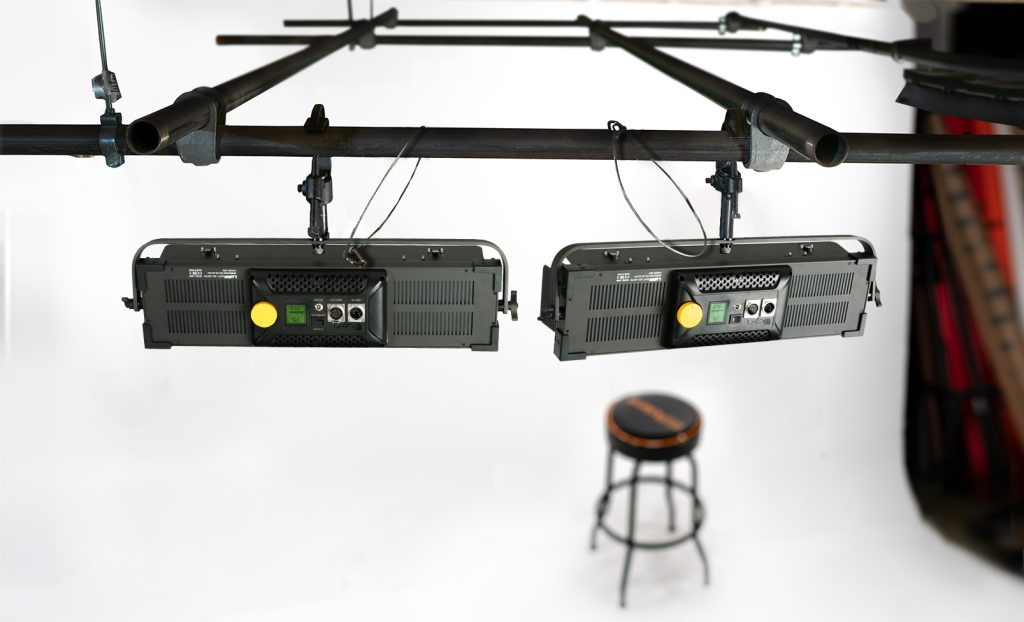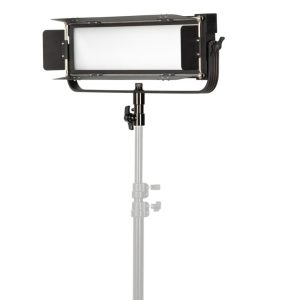
A DMX lighting system offers centralized, precise control over multiple lighting fixtures—making it an essential component in modern video production, live events, and broadcast studios. Short for Digital Multiplex, DMX technology relies on the DMX512 protocol, a global standard introduced by USITT in 1986, which allows lighting designers to manage brightness, color, and effects across hundreds of lights from a single controller.
Whether you’re building your first setup or upgrading an existing rig, understanding how to set up a DMX lighting system can dramatically improve the quality and flexibility of your production environment.
What You’ll Learn in This Guide:
- What a DMX lighting system is and how it works
- Key equipment needed, including LED lights, controllers, and cables
- How to assign DMX addresses and configure your setup
- Troubleshooting tips for signal issues and performance problems
- How to expand your system as your production grows
This step-by-step guide will help you confidently design and configure a DMX setup that meets professional standards and adapts to your evolving production needs.
What is a DMX Lighting System?
A DMX lighting system is a digital control network used to manage multiple lighting fixtures from a single controller. It allows users to control brightness, color temperature, effects, and movement with precision and flexibility, making it a cornerstone for theaters, broadcast studios, concerts, and live events.
DMX stands for Digital Multiplex, and it operates using the DMX512 protocol, which was established in 1986 by the United States Institute for Theatre Technology (USITT). The DMX512 standard enables the transfer of 512 channels of data over a single cable, providing seamless communication between the controller and lighting fixtures. Similar to advancements in network-controlled systems like PoE standards, DMX has revolutionized lighting control by simplifying setups and improving flexibility for professionals.
Key Terms to Know
- DMX512 Protocol: The industry-standard protocol that transmits digital signals to control lighting fixtures. Each signal contains 512 channels, allowing users to manage multiple lights and effects simultaneously.
- DMX Universe: A DMX Universe represents a group of 512 channels. Each channel controls a specific function (e.g., brightness or color) within a light fixture. Larger productions may use multiple universes to control hundreds of lights from one DMX controller.
- DMX Addresses: Each lighting fixture is assigned a starting address within a DMX Universe to determine which channels it will respond to. Proper addressing ensures synchronized operation and accurate control over lighting effects.
How DMX Lighting Is Used
DMX lighting systems are a staple in professional environments thanks to their precision, reliability, and creative flexibility. From live events to controlled studio settings, DMX technology enhances the visual experience across a wide range of productions:
- Theaters and Stage Productions: Create dynamic lighting effects for performances, scene changes, and cues, all with seamless transitions.
- Broadcast Studios: Ensure consistent and flattering lighting for interviews, newsrooms, and live shows, where precision is critical.
- Concerts and Events: Synchronize lighting effects with music and stage action to deliver immersive, high-energy experiences.
- Film and Video Production: Achieve cinematic lighting by adjusting brightness, tone, and effects to suit each shot or scene.
If you’re looking to implement these techniques in your own setup, explore our DMX lighting integration guide for a deeper dive into best practices and setup steps.
Equipment Needed for a DMX Lighting System
To get the most out of a DMX lighting system, it’s essential to use the right equipment. A well-configured setup ensures reliable signal transmission, precise control, and professional-grade lighting performance. Below is a breakdown of the core components you’ll need—and what to look for when selecting them.
DMX LED Lights
DMX LED lights form the foundation of your lighting system. Engineered for remote control via DMX signals, these fixtures allow users to fine-tune brightness, color temperature, and effects with precision. Their energy efficiency and versatility make them a go-to for broadcast studios, live productions, and film sets.
Key Features of DMX LED Lights:
- Precision Control: Make real-time adjustments to dimming, color changes, and effects.
- Energy-Efficient and Durable: Consume less power and have long lifespans, making them cost-effective for long-term use.
- Versatile Applications: Suitable for both indoor studio setups and outdoor shoots, offering flexibility for varied productions.
Compatibility Tip:Always confirm your lights are DMX512-compatible for seamless integration. If you’re working with non-DMX fixtures, you can still achieve basic control using DMX dimmers.
DMX Controller
The DMX controller serves as the command center of your lighting system, allowing you to adjust settings, program scenes, and manage effects across multiple fixtures with precision and ease.
Types of DMX Controllers:
- Physical Controllers: Best for live events and real-time adjustments. Feature sliders, knobs, and buttons for hands-on control during dynamic productions.
- Software-Based Controllers: Ideal for pre-programmed cues, scene transitions, and automated effects.They operate through laptops, tablets, or computers, offering advanced programming options.
Choosing the Right Controller:
- Physical controllers are great for live performances that require immediate adjustments.
- Software-based controllers are better suited for complex lighting effects and pre-planned sequences.
DMX Cables and Terminators
DMX cables and terminators are critical components that ensure your lighting signals are stable, consistent, and error-free throughout your setup. Using high-quality cables and terminators prevents signal loss, interference, and flickering issues. Browse our selection of DMX lighting equipment to complete your professional setup.
DMX Cable Standards:
- Use DMX512-compliant cables with 5-pin XLR connectors for optimal performance and signal integrity.
- While 3-pin XLR cables can sometimes work, 5-pin options are recommended for better reliability and compatibility.
Why Terminators Are Important:
A DMX terminator is placed at the end of a DMX chain to prevent signal reflections and data errors. Without a terminator, signals can bounce back, causing flickering lights and unresponsive fixtures. For longer chains, terminators are essential to maintain signal stability.
Tips for Optimizing Your DMX Lighting Setup
A DMX lighting system is only as powerful as the strategy behind it. Proper setup, ongoing maintenance, and smart expansion planning are key to achieving consistent, high-quality lighting across productions. Below are key optimization tips that will help you reduce downtime, improve performance, and ensure your lighting setup is ready for anything.
Testing and Troubleshooting
Regular testing and troubleshooting are essential to prevent last-minute surprises during live events or recordings. Follow these steps before every production:
- Inspect All Cables and Connections: Check for damaged wires, loose fittings, or compromised connectors.
- Verify DMX Addresses: Ensure fixture addresses match your controller’s programming to avoid cross-talk or misfires.
- Test Each Fixture Individually: This helps isolate any signal drops, lag, or flickering before going live.
- Confirm Proper Termination: Make sure your DMX terminator is installed at the end of the chain to prevent signal reflections and data errors.
Pro Tip: Don’t substitute audio XLR cables for DMX-specific ones-this can result in signal degradation. Always use DMX512-compliant cables for reliable performance.
For more professional lighting advice, check out our guide on choosing studio lighting.
Expanding Your Setup
As production needs evolve, your DMX system should scale with you. Whether you’re adding new fixtures, increasing the number of channels, or implementing more complex effects, here are some tips for smart expansion:
- Add DMX Splitters: These allow you to branch signals to multiple lighting zones while maintaining signal strength.
- Upgrade to Multi-Universe Controllers: Manage more than 512 channels to support larger productions.
- Explore Wireless DMX: Ideal for mobile or large-scale setups, wireless systems reduce clutter and speed up installation.
- Invest in Future-Proof Gear: Choosing software-based controllers or modular lighting systems ensures long-term compatibility with evolving DMX standards.
Keep Your Firmware and Software Updated
Manufacturers frequently release firmware updates and controller software enhancements that improve functionality, fix bugs, and expand compatibility with newer DMX lighting fixtures.
- Why it matters: Outdated software can limit your control options or cause glitches during complex scenes.
- What to do: Regularly check for updates for your DMX controller, lighting software, and even smart fixtures.
This is especially important when using software-based DMX controllers or integrating with PoE and smart lighting systems.
Benefits of Using DMX Lighting Systems

DMX lighting systems deliver unmatched precision, flexibility, and scalability—making them a cornerstone of professional production environments. Whether you’re in a broadcast studio, live venue, or film set, here’s how DMX lighting gives your setup a competitive edge:
- Centralized Control and Automation: A DMX controller allows you to manage multiple fixtures from a single interface, enabling synchronized effects, preset scenes, and automated transitions for dynamic lighting displays.
- Efficiency and Energy Savings: Modern DMX LED lights consume less power than traditional lighting, helping reduce energy costs while providing consistent brightness and longer lifespans for cost-effective performance.
- Flexible Applications: From studios to live events, DMX systems offer customizable lighting to suit any environment. Adjust color temperature, dimming, and special effects to create unique moods and atmospheres for each production.
- Scalable for Growth: Whether you’re working on a small shoot or a large-scale performance, DMX systems can be easily expanded with additional fixtures and wireless options, ensuring you’re prepared for future demands.
With their blend of precision, reliability, and adaptability, DMX lighting systems empower production teams to deliver stunning visuals across a range of creative environments. Whether you’re building your first setup or expanding an existing one, investing in DMX ensures your lighting can keep pace with your vision now and into the future.
Ready to Upgrade Your Lighting Setup?
Whether you’re building your first DMX lighting system or expanding an existing one, the right equipment can transform your production quality. At Ikan, we provide a full range of DMX-compatible LED lights, controllers, and accessories engineered for professional performance and easy integration.
Explore our DMX lighting solutions and discover how our gear can elevate your workflow. Have questions or need help selecting the right setup? Contact our team today, we’re here to help.
FAQs About Setting Up a DMX Lighting System
1. What is a DMX lighting system?
A DMX lighting system is a digital control network that allows you to remotely control lighting fixtures from a centralized controller. It uses the DMX512 protocol, which supports up to 512 channels in a single universe, enabling users to adjust brightness, color temperature, effects, and movement with precision.
2. What equipment do I need for a DMX lighting setup?
To set up a DMX lighting system, you’ll need:
- DMX LED Lights with DMX in/out ports for chaining.
- A DMX controller (physical or software-based) to program and operate the lights.
- DMX cables (5-pin or compatible 3-pin XLR) for data transmission.
- A DMX terminator to prevent signal interference in larger setups.
3. How do I assign addresses to DMX lights?
Each DMX light requires a starting address to determine which channels the controller will use for that fixture. Assign the first light to channel 1, then calculate the next address based on the number of channels each light occupies. For example, a 4-channel light starting at channel 1 would leave the next fixture starting at channel 5. Use DIP switches or digital displays on the light to input addresses.
4. What are DMX terminators, and why are they important?
A DMX terminator is a resistor plug that connects to the last light in the DMX chain. It absorbs signal reflections, preventing flickering, delays, or data errors caused by interference. Terminators are especially important in long signal chains or setups with multiple fixtures.
5. Can I expand my DMX lighting system later?
Yes, DMX systems are scalable. You can:
- Add more lights by connecting them to your existing chain (up to 512 channels per universe).
- Use DMX splitters to branch signals and increase the number of devices.
- Upgrade to multi-universe controllers or wireless DMX systems for larger or complex setups.
